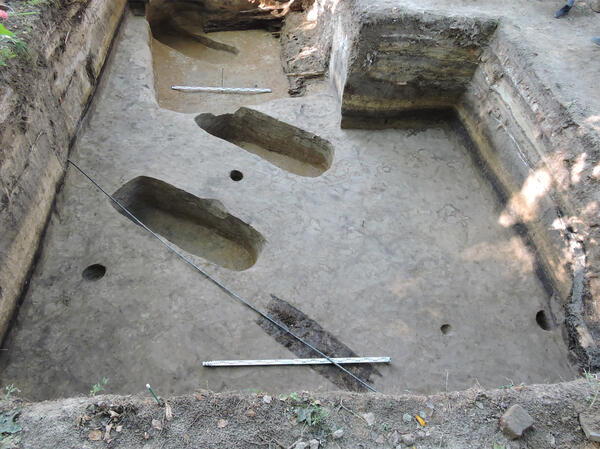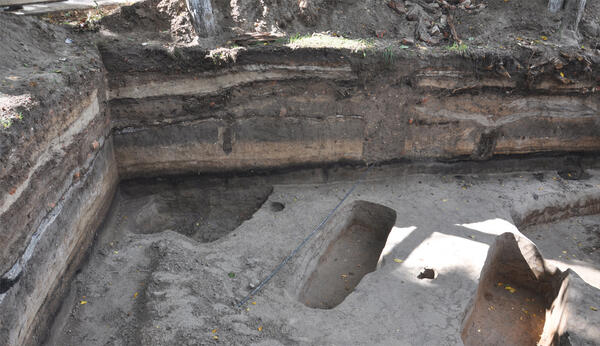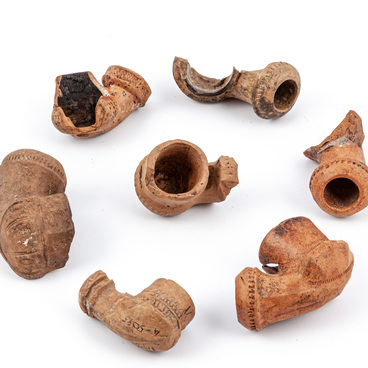In 2016, the cultural deposit, formed between the second half of the 12th century and the 13th century and located on Lenin Street in the central part of Gorokhovets, revealed a fragment of a twisted torc (a decoration in the form of a neck ring), a bottle-shaped pendant and a pendant with paw-shaped charms. Such objects are considered typical of the 9th–11th centuries and are usually found in cemeteries and settlements of that time.
In the 11th century, twisted torcs with flattened hooks were widespread in the lands of Northern Russia. The charm and the pendant, found on the site, belonged to the Finns, who were the indigenous population of the Volga-Klyazma interfluve before the Slavic colonization.
At that time, there was no settlement on this site yet, as evidenced by the complete lack of molded pottery. The archaeologists assumed that the items they found belonged to a grave site located in the area.
To verify this information, two pits with a total area of 88 square meters were dug in 2017. To their surprise, the archaeologists found a unique soil grave field dated as early as the beginning of the 1st millennium AD.
Three inhumations were explored in one of the excavations. All of them were placed according to the rite of natural burial. The deceased were laid on their backs, with their heads oriented toward the west, in one case — to the east. Although the anthropological material had not been preserved, judging by the items, it was established that all the graves belonged to men.
The find included a celt ax, a spearhead, iron ring bits, knives, and two fibulas. In one of the burials, the archaeologists found ornaments made from non-ferrous metal: a syulgama (a fibula), a belt buckle, and charms.
The fact that makes this archaeological find so unique is that the discovered inhumations belong to the Andreevka-Piseraly type of burial grounds. Similar burial grounds were found in neighboring territories of Mordovia, the Ryazan region, and others. The objects from the graves hint at the high level of militarization of this understudied Finno-Ugric tribe. Its members participated in military campaigns as mercenaries — they even fought against the Romans. In general, Finnish burial grounds in this area are a truly rare occasion.
In the 11th century, twisted torcs with flattened hooks were widespread in the lands of Northern Russia. The charm and the pendant, found on the site, belonged to the Finns, who were the indigenous population of the Volga-Klyazma interfluve before the Slavic colonization.
At that time, there was no settlement on this site yet, as evidenced by the complete lack of molded pottery. The archaeologists assumed that the items they found belonged to a grave site located in the area.
To verify this information, two pits with a total area of 88 square meters were dug in 2017. To their surprise, the archaeologists found a unique soil grave field dated as early as the beginning of the 1st millennium AD.
Three inhumations were explored in one of the excavations. All of them were placed according to the rite of natural burial. The deceased were laid on their backs, with their heads oriented toward the west, in one case — to the east. Although the anthropological material had not been preserved, judging by the items, it was established that all the graves belonged to men.
The find included a celt ax, a spearhead, iron ring bits, knives, and two fibulas. In one of the burials, the archaeologists found ornaments made from non-ferrous metal: a syulgama (a fibula), a belt buckle, and charms.
The fact that makes this archaeological find so unique is that the discovered inhumations belong to the Andreevka-Piseraly type of burial grounds. Similar burial grounds were found in neighboring territories of Mordovia, the Ryazan region, and others. The objects from the graves hint at the high level of militarization of this understudied Finno-Ugric tribe. Its members participated in military campaigns as mercenaries — they even fought against the Romans. In general, Finnish burial grounds in this area are a truly rare occasion.




